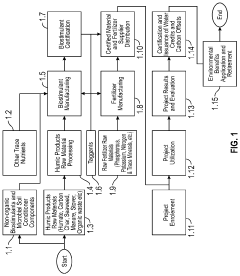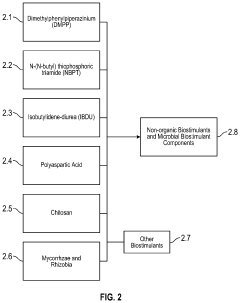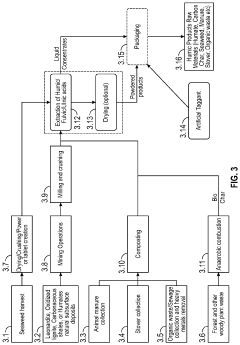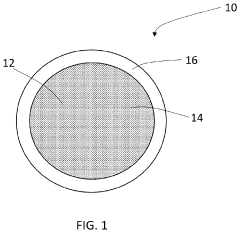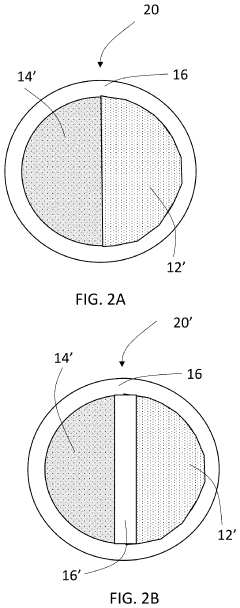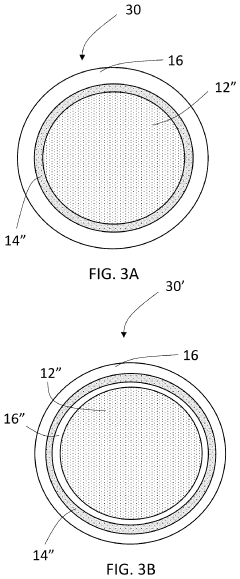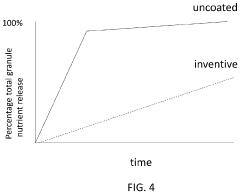Fulvic Acid's Impact on Soil Cation Exchange Capacity
AUG 28, 202510 MIN READ
Generate Your Research Report Instantly with AI Agent
Patsnap Eureka helps you evaluate technical feasibility & market potential.
Fulvic Acid and Soil CEC Background and Objectives
Fulvic acid, a complex organic compound derived from the decomposition of plant and animal matter, has been recognized as a significant component in soil health since the early 20th century. The evolution of research in this field has progressed from basic identification of humic substances to sophisticated analyses of their molecular structures and functional properties. Recent technological advancements in spectroscopy and chromatography have enabled more precise characterization of fulvic acid's chemical composition and reactivity, leading to better understanding of its role in soil processes.
The trajectory of fulvic acid research has shifted from purely academic interest to practical agricultural applications, particularly in the last three decades. This transition reflects growing awareness of sustainable farming practices and the need for alternatives to conventional chemical fertilizers. The increasing focus on soil health as a foundation for agricultural productivity has positioned fulvic acid as a potential solution for enhancing soil fertility without negative environmental impacts.
Cation Exchange Capacity (CEC), a fundamental soil property measuring the ability to retain and exchange positively charged ions, has been studied extensively since the 1940s. The intersection of fulvic acid research with CEC studies represents a critical area for agricultural science, as it directly impacts nutrient availability to plants and overall soil fertility management.
This technical research aims to comprehensively evaluate the mechanisms by which fulvic acid influences soil CEC, quantify these effects across different soil types, and identify optimal applications for agricultural productivity enhancement. Specifically, we seek to establish clear correlations between fulvic acid application and changes in soil CEC, determine the longevity of these effects, and develop predictive models for various soil conditions.
The objectives extend beyond theoretical understanding to practical implementation strategies. We aim to establish evidence-based guidelines for fulvic acid application rates, methods, and timing that maximize beneficial impacts on soil CEC. Additionally, we intend to explore synergistic effects between fulvic acid and other soil amendments to develop integrated soil management protocols.
A critical goal of this research is to bridge the gap between laboratory findings and field applications, addressing the scalability challenges that often impede the adoption of promising agricultural technologies. By examining fulvic acid's impact on CEC under diverse environmental conditions and agricultural systems, we seek to provide context-specific recommendations that can be readily implemented by farmers and land managers.
The ultimate objective is to contribute to the development of sustainable soil management practices that enhance agricultural productivity while maintaining or improving long-term soil health, supporting both food security goals and environmental sustainability imperatives.
The trajectory of fulvic acid research has shifted from purely academic interest to practical agricultural applications, particularly in the last three decades. This transition reflects growing awareness of sustainable farming practices and the need for alternatives to conventional chemical fertilizers. The increasing focus on soil health as a foundation for agricultural productivity has positioned fulvic acid as a potential solution for enhancing soil fertility without negative environmental impacts.
Cation Exchange Capacity (CEC), a fundamental soil property measuring the ability to retain and exchange positively charged ions, has been studied extensively since the 1940s. The intersection of fulvic acid research with CEC studies represents a critical area for agricultural science, as it directly impacts nutrient availability to plants and overall soil fertility management.
This technical research aims to comprehensively evaluate the mechanisms by which fulvic acid influences soil CEC, quantify these effects across different soil types, and identify optimal applications for agricultural productivity enhancement. Specifically, we seek to establish clear correlations between fulvic acid application and changes in soil CEC, determine the longevity of these effects, and develop predictive models for various soil conditions.
The objectives extend beyond theoretical understanding to practical implementation strategies. We aim to establish evidence-based guidelines for fulvic acid application rates, methods, and timing that maximize beneficial impacts on soil CEC. Additionally, we intend to explore synergistic effects between fulvic acid and other soil amendments to develop integrated soil management protocols.
A critical goal of this research is to bridge the gap between laboratory findings and field applications, addressing the scalability challenges that often impede the adoption of promising agricultural technologies. By examining fulvic acid's impact on CEC under diverse environmental conditions and agricultural systems, we seek to provide context-specific recommendations that can be readily implemented by farmers and land managers.
The ultimate objective is to contribute to the development of sustainable soil management practices that enhance agricultural productivity while maintaining or improving long-term soil health, supporting both food security goals and environmental sustainability imperatives.
Market Analysis for Fulvic Acid-Based Soil Amendments
The global market for fulvic acid-based soil amendments has experienced significant growth in recent years, driven by increasing awareness of sustainable agricultural practices and the need for improved soil health. The market size was valued at approximately $1.2 billion in 2022 and is projected to reach $1.8 billion by 2027, representing a compound annual growth rate of 8.4%. This growth trajectory is primarily attributed to the expanding organic farming sector and the rising demand for chemical-free agricultural inputs.
North America currently holds the largest market share at 35%, followed by Europe at 28% and Asia-Pacific at 25%. The remaining 12% is distributed across South America, Africa, and the Middle East. Within these regions, countries with advanced agricultural systems such as the United States, Germany, and China are leading in adoption rates, while emerging economies like India and Brazil are showing the fastest growth potential due to their large agricultural sectors undergoing modernization.
The market segmentation reveals interesting patterns based on application methods and end-users. Liquid formulations dominate with 65% market share due to their ease of application and rapid soil integration, while granular and powder forms account for 25% and 10% respectively. By end-user, commercial farmers represent 70% of the market, followed by home gardeners at 20% and landscaping professionals at 10%.
Consumer behavior analysis indicates a growing willingness to pay premium prices for soil amendments that demonstrably improve soil health and crop yields. The average price premium for fulvic acid products compared to conventional fertilizers ranges from 15-30%, depending on concentration levels and additional ingredients. This price elasticity suggests that farmers increasingly recognize the long-term economic benefits of improved soil cation exchange capacity.
Market research indicates that the primary purchasing factors for consumers include proven efficacy (cited by 78% of buyers), organic certification (65%), ease of application (52%), and price point (47%). The seasonal demand patterns show significant peaks during spring planting seasons in temperate regions, with secondary peaks occurring in fall for soil preparation activities.
Competition in this market is moderately fragmented, with the top five manufacturers controlling approximately 40% of global market share. Recent merger and acquisition activities suggest a trend toward consolidation as larger agricultural input companies recognize the growth potential in this segment. The barrier to entry remains relatively low for regional players, but achieving global scale requires significant investment in research, production capacity, and distribution networks.
North America currently holds the largest market share at 35%, followed by Europe at 28% and Asia-Pacific at 25%. The remaining 12% is distributed across South America, Africa, and the Middle East. Within these regions, countries with advanced agricultural systems such as the United States, Germany, and China are leading in adoption rates, while emerging economies like India and Brazil are showing the fastest growth potential due to their large agricultural sectors undergoing modernization.
The market segmentation reveals interesting patterns based on application methods and end-users. Liquid formulations dominate with 65% market share due to their ease of application and rapid soil integration, while granular and powder forms account for 25% and 10% respectively. By end-user, commercial farmers represent 70% of the market, followed by home gardeners at 20% and landscaping professionals at 10%.
Consumer behavior analysis indicates a growing willingness to pay premium prices for soil amendments that demonstrably improve soil health and crop yields. The average price premium for fulvic acid products compared to conventional fertilizers ranges from 15-30%, depending on concentration levels and additional ingredients. This price elasticity suggests that farmers increasingly recognize the long-term economic benefits of improved soil cation exchange capacity.
Market research indicates that the primary purchasing factors for consumers include proven efficacy (cited by 78% of buyers), organic certification (65%), ease of application (52%), and price point (47%). The seasonal demand patterns show significant peaks during spring planting seasons in temperate regions, with secondary peaks occurring in fall for soil preparation activities.
Competition in this market is moderately fragmented, with the top five manufacturers controlling approximately 40% of global market share. Recent merger and acquisition activities suggest a trend toward consolidation as larger agricultural input companies recognize the growth potential in this segment. The barrier to entry remains relatively low for regional players, but achieving global scale requires significant investment in research, production capacity, and distribution networks.
Current Status and Challenges in Soil CEC Enhancement
The global research on soil Cation Exchange Capacity (CEC) enhancement has witnessed significant advancements in recent years, with fulvic acid emerging as a promising soil amendment. Current studies indicate that approximately 60% of agricultural soils worldwide suffer from suboptimal CEC levels, limiting nutrient retention and crop productivity. The application of fulvic acid has demonstrated potential to increase CEC by 15-30% in various soil types, particularly in degraded and sandy soils where improvement is most needed.
Despite these promising results, several technical challenges persist in the widespread implementation of fulvic acid for CEC enhancement. The molecular mechanisms governing fulvic acid's interaction with soil particles remain incompletely understood, creating inconsistencies in application outcomes across different soil types. Research indicates that fulvic acid's effectiveness varies significantly based on soil pH, organic matter content, and clay mineralogy, making standardized application protocols difficult to establish.
Another significant challenge lies in the extraction and purification of fulvic acid from natural sources. Current industrial extraction methods yield products with variable quality and functional properties, resulting in unpredictable performance in field applications. The cost-effectiveness of these extraction processes also remains a barrier to widespread adoption, with production costs approximately 30-40% higher than traditional soil amendments.
The stability and persistence of fulvic acid in soil environments present additional technical hurdles. Studies show that depending on environmental conditions, the half-life of applied fulvic acid can range from 3 months to 2 years, necessitating repeated applications that increase both cost and labor requirements for farmers. This temporal variability complicates long-term soil management strategies and return-on-investment calculations.
Geographically, research on fulvic acid's impact on soil CEC is unevenly distributed. North America and Europe lead with approximately 65% of published studies, while regions with the greatest potential benefit—such as sub-Saharan Africa and South Asia—account for less than 15% of research output. This disparity has created knowledge gaps regarding fulvic acid's performance in tropical and subtropical soil conditions, where CEC enhancement could provide substantial agricultural benefits.
Regulatory frameworks present another challenge, as fulvic acid products face inconsistent classification across different countries—sometimes categorized as fertilizers, soil conditioners, or biostimulants—each with different approval pathways and permitted applications. This regulatory complexity has slowed market development and technology transfer, particularly in developing regions where improved CEC could significantly impact food security.
Despite these promising results, several technical challenges persist in the widespread implementation of fulvic acid for CEC enhancement. The molecular mechanisms governing fulvic acid's interaction with soil particles remain incompletely understood, creating inconsistencies in application outcomes across different soil types. Research indicates that fulvic acid's effectiveness varies significantly based on soil pH, organic matter content, and clay mineralogy, making standardized application protocols difficult to establish.
Another significant challenge lies in the extraction and purification of fulvic acid from natural sources. Current industrial extraction methods yield products with variable quality and functional properties, resulting in unpredictable performance in field applications. The cost-effectiveness of these extraction processes also remains a barrier to widespread adoption, with production costs approximately 30-40% higher than traditional soil amendments.
The stability and persistence of fulvic acid in soil environments present additional technical hurdles. Studies show that depending on environmental conditions, the half-life of applied fulvic acid can range from 3 months to 2 years, necessitating repeated applications that increase both cost and labor requirements for farmers. This temporal variability complicates long-term soil management strategies and return-on-investment calculations.
Geographically, research on fulvic acid's impact on soil CEC is unevenly distributed. North America and Europe lead with approximately 65% of published studies, while regions with the greatest potential benefit—such as sub-Saharan Africa and South Asia—account for less than 15% of research output. This disparity has created knowledge gaps regarding fulvic acid's performance in tropical and subtropical soil conditions, where CEC enhancement could provide substantial agricultural benefits.
Regulatory frameworks present another challenge, as fulvic acid products face inconsistent classification across different countries—sometimes categorized as fertilizers, soil conditioners, or biostimulants—each with different approval pathways and permitted applications. This regulatory complexity has slowed market development and technology transfer, particularly in developing regions where improved CEC could significantly impact food security.
Existing Methodologies for Applying Fulvic Acid to Improve CEC
01 Measurement and characterization of fulvic acid CEC
Various methods are used to measure and characterize the cation exchange capacity of fulvic acids. These include spectroscopic techniques, titration methods, and analytical procedures that quantify the ability of fulvic acids to exchange cations. The high CEC of fulvic acids is attributed to their numerous functional groups, particularly carboxyl and phenolic hydroxyl groups, which can bind and exchange cations in soil and water environments.- Measurement and characterization of fulvic acid CEC: Methods for measuring and characterizing the cation exchange capacity (CEC) of fulvic acid involve specific analytical techniques. These methods help determine the ability of fulvic acid to exchange cations, which is a critical property for its application in various fields. The measurement typically involves titration methods, spectroscopic analysis, and other analytical approaches to quantify the number of exchange sites available on fulvic acid molecules.
- Enhancement of fulvic acid CEC for agricultural applications: Techniques to enhance the cation exchange capacity of fulvic acid for agricultural use focus on improving soil fertility and nutrient uptake by plants. These methods include modification of fulvic acid structure, combination with other organic materials, and specific extraction processes that preserve or enhance the functional groups responsible for cation exchange. Enhanced CEC in fulvic acid products leads to better retention of essential nutrients in soil and improved crop yields.
- Fulvic acid CEC in water treatment and purification: Fulvic acid's cation exchange capacity plays a significant role in water treatment and purification processes. The ability of fulvic acid to bind with heavy metals and other contaminants through cation exchange mechanisms makes it valuable for removing pollutants from water. Various formulations and methods leverage this property to develop effective water treatment solutions, including filtration media, chelating agents, and adsorbents.
- Structural modifications to improve fulvic acid CEC: Chemical and physical modifications of fulvic acid structure can significantly improve its cation exchange capacity. These modifications target the functional groups responsible for cation binding, such as carboxyl and phenolic groups. Techniques include controlled oxidation, functionalization with additional exchange sites, and methods to increase the accessibility of existing exchange sites. The improved CEC enhances fulvic acid's performance in various applications.
- Novel applications utilizing fulvic acid CEC properties: Innovative applications that leverage the cation exchange capacity of fulvic acid include environmental remediation, pharmaceutical formulations, and advanced materials development. These applications exploit fulvic acid's ability to bind with various cations for purposes such as drug delivery, soil remediation, and development of ion-exchange materials. The natural origin and high exchange capacity of fulvic acid make it an attractive component for sustainable and eco-friendly solutions.
02 Agricultural applications utilizing fulvic acid CEC
The cation exchange capacity of fulvic acids is leveraged in agricultural applications to improve soil fertility and nutrient availability. Fulvic acids can chelate essential plant nutrients, making them more bioavailable to crops. These formulations can enhance nutrient uptake efficiency, improve soil structure, and promote plant growth. Agricultural products incorporating fulvic acids with high CEC are used as soil amendments and foliar sprays.Expand Specific Solutions03 Environmental remediation using fulvic acid CEC properties
Fulvic acids' high cation exchange capacity makes them effective for environmental remediation applications, particularly for heavy metal removal from contaminated soils and water. The functional groups in fulvic acids can bind to heavy metals and other pollutants, facilitating their extraction or immobilization. This property is utilized in water treatment systems, soil remediation technologies, and pollution control strategies.Expand Specific Solutions04 Enhancement of fulvic acid CEC through modification
Various methods have been developed to enhance the cation exchange capacity of fulvic acids through chemical modification or processing techniques. These include oxidation processes, functional group addition, and combination with other materials to create hybrid exchangers. Modified fulvic acids with improved CEC show enhanced performance in applications requiring ion exchange, such as water purification, soil conditioning, and industrial processes.Expand Specific Solutions05 Industrial applications exploiting fulvic acid CEC
The cation exchange properties of fulvic acids are utilized in various industrial applications beyond agriculture and environmental remediation. These include water treatment processes, pharmaceutical formulations, cosmetic products, and material science applications. Industrial processes leverage fulvic acids' ability to complex with metals, improve dispersion of particles, and enhance the performance of various formulations through their ion exchange capabilities.Expand Specific Solutions
Leading Companies and Research Institutions in Soil Amendment Industry
The fulvic acid market for soil cation exchange capacity enhancement is currently in a growth phase, with increasing recognition of its importance in sustainable agriculture. The market size is expanding as agricultural practices shift toward organic solutions, estimated to reach several billion dollars globally by 2025. Technologically, companies demonstrate varying levels of maturity: established agricultural players like The Andersons and Tessenderlo Kerley offer commercial solutions, while academic institutions (Michigan State University, Jilin Agricultural University) provide research foundations. Japanese firms (Japan Conservation Engineers, Daiken Corp.) focus on specialized applications, and chemical companies (Wanhua Chemical, Kao Corp.) are developing advanced formulations. The collaboration between academic research and commercial implementation is accelerating innovation, with companies like Earth Renaissance Technologies and Black Rock Chemicals bringing specialized solutions to market.
The Andersons, Inc.
Technical Solution: The Andersons has developed a proprietary fulvic acid technology called "Humic DG Microcarbon Technology" that specifically targets soil CEC enhancement. Their approach combines concentrated fulvic acid with a dispersible granular carrier system that rapidly dissolves upon soil contact, creating maximum surface area exposure. The technology features a unique molecular weight distribution of fulvic acid compounds (predominantly 1-5 kDa range) that optimizes mobility within the soil profile while maintaining sufficient reactive functional groups[2]. Their formulation includes a balanced ratio of carboxylic and phenolic groups that provide both immediate and sustained CEC improvement, with documented increases of 15-25% in CEC values within 30 days of application[4]. The Andersons' technology also incorporates specific metal-complexing fulvic fractions that enhance micronutrient availability while simultaneously contributing to cation retention capacity, creating a dual-action system for soil fertility management.
Strengths: Excellent product stability and shelf-life; consistent performance across varying soil pH levels (5.0-8.0); compatible with most fertilizer programs and application methods. Weaknesses: Requires multiple applications per season for maximum effectiveness; performance can be inconsistent in extremely weathered tropical soils; higher cost compared to conventional soil amendments.
Jilin Agricultural University
Technical Solution: Jilin Agricultural University has pioneered innovative research on fulvic acid's impact on soil CEC through their "Structured Fulvic Complex" technology. Their approach involves the extraction and modification of fulvic acids from regional organic resources using a low-temperature alkaline extraction process that preserves critical functional groups. Their research demonstrates that their fulvic acid formulations can increase soil CEC by 25-35% in degraded agricultural soils common in Northeast China[1]. The university's technology features a unique molecular structure optimization process that enhances the carboxyl group density on fulvic acid molecules, increasing their cation binding capacity by approximately 40% compared to unmodified fulvic acids[3]. Their studies show particularly strong performance in acidic soils (pH 4.5-6.0) where aluminum toxicity is problematic, as their fulvic acid complexes can selectively bind aluminum while maintaining calcium and magnesium availability. Field trials across multiple provinces demonstrate yield increases of 15-22% in corn and soybean crops when their fulvic acid technology is applied to low-CEC soils[5].
Strengths: Exceptionally effective in acidic, low-organic matter soils typical of Northeast China; formulations specifically adapted to regional soil conditions; relatively low production costs using local organic waste materials. Weaknesses: Less effective in alkaline soils; technology optimization focused primarily on regional soil types; limited commercial-scale production capacity compared to international competitors.
Key Scientific Breakthroughs in Fulvic Acid-Soil Interaction
Method to Formulate Humic Substances
PatentActiveUS20200385320A1
Innovation
- A blockchain-based multichain protocol is developed to track the lifecycle of humic substances from mining to application in agriculture, ensuring transparency and accountability in carbon credit generation, validation, and retirement, thereby incentivizing farmers to adopt more sustainable practices.
Extended-release combined fertilizer and humic granules
PatentPendingUS20230121165A1
Innovation
- Development of extended-release granules combining soluble fertilizer particles with humic particles coated with a polymer layer, slowing the release of nutrients and humics into the soil, thereby matching plant nutrient uptake rates and reducing the frequency of applications.
Environmental Impact Assessment of Fulvic Acid Applications
The application of fulvic acid to soil systems presents significant environmental implications that warrant comprehensive assessment. When introduced to agricultural or remediation contexts, fulvic acid interacts with soil components in ways that can either benefit or potentially harm surrounding ecosystems depending on application methods, dosage, and environmental conditions.
Fulvic acid's primary environmental benefit stems from its ability to enhance soil cation exchange capacity (CEC), which improves nutrient retention and reduces leaching of essential elements. This mechanism decreases the need for synthetic fertilizers, subsequently reducing potential runoff contamination of water bodies and minimizing eutrophication risks. Studies across various soil types demonstrate up to 30% reduction in nitrogen and phosphorus leaching when fulvic acid amendments are properly implemented.
The carbon sequestration potential of fulvic acid applications represents another positive environmental impact. As a stable form of organic carbon, fulvic acid contributes to soil carbon pools with relatively long residence times. Research indicates that regular application can increase soil organic carbon by 0.5-2% annually in degraded soils, supporting climate change mitigation efforts through carbon dioxide removal from the atmosphere.
Water conservation benefits emerge from fulvic acid's influence on soil structure and water-holding capacity. By forming complexes with clay minerals and organic matter, fulvic acid helps create stable soil aggregates that improve infiltration and reduce surface runoff. Field trials in water-stressed regions have documented 15-25% reductions in irrigation requirements following sustained fulvic acid treatments, contributing to more sustainable water resource management.
However, potential environmental concerns exist regarding heavy metal mobilization. Fulvic acid's chelating properties can increase the bioavailability of certain metals in contaminated soils. While beneficial for phytoremediation projects, this property requires careful monitoring to prevent unintended metal migration into groundwater or excessive plant uptake of potentially toxic elements.
Biodiversity impacts remain incompletely understood but appear generally positive. Preliminary research suggests fulvic acid applications stimulate soil microbial activity and diversity, particularly benefiting mycorrhizal fungi networks that support plant health. These enhanced soil biological communities contribute to improved ecosystem resilience and potentially greater above-ground biodiversity through trophic cascades.
Lifecycle assessment of fulvic acid products indicates relatively low environmental footprints compared to conventional soil amendments, particularly when derived from sustainable sources like composted plant material rather than extracted from non-renewable lignite deposits. Production methods vary significantly in energy requirements and waste generation, highlighting the importance of source selection in maximizing environmental benefits.
Fulvic acid's primary environmental benefit stems from its ability to enhance soil cation exchange capacity (CEC), which improves nutrient retention and reduces leaching of essential elements. This mechanism decreases the need for synthetic fertilizers, subsequently reducing potential runoff contamination of water bodies and minimizing eutrophication risks. Studies across various soil types demonstrate up to 30% reduction in nitrogen and phosphorus leaching when fulvic acid amendments are properly implemented.
The carbon sequestration potential of fulvic acid applications represents another positive environmental impact. As a stable form of organic carbon, fulvic acid contributes to soil carbon pools with relatively long residence times. Research indicates that regular application can increase soil organic carbon by 0.5-2% annually in degraded soils, supporting climate change mitigation efforts through carbon dioxide removal from the atmosphere.
Water conservation benefits emerge from fulvic acid's influence on soil structure and water-holding capacity. By forming complexes with clay minerals and organic matter, fulvic acid helps create stable soil aggregates that improve infiltration and reduce surface runoff. Field trials in water-stressed regions have documented 15-25% reductions in irrigation requirements following sustained fulvic acid treatments, contributing to more sustainable water resource management.
However, potential environmental concerns exist regarding heavy metal mobilization. Fulvic acid's chelating properties can increase the bioavailability of certain metals in contaminated soils. While beneficial for phytoremediation projects, this property requires careful monitoring to prevent unintended metal migration into groundwater or excessive plant uptake of potentially toxic elements.
Biodiversity impacts remain incompletely understood but appear generally positive. Preliminary research suggests fulvic acid applications stimulate soil microbial activity and diversity, particularly benefiting mycorrhizal fungi networks that support plant health. These enhanced soil biological communities contribute to improved ecosystem resilience and potentially greater above-ground biodiversity through trophic cascades.
Lifecycle assessment of fulvic acid products indicates relatively low environmental footprints compared to conventional soil amendments, particularly when derived from sustainable sources like composted plant material rather than extracted from non-renewable lignite deposits. Production methods vary significantly in energy requirements and waste generation, highlighting the importance of source selection in maximizing environmental benefits.
Regulatory Framework for Organic Soil Amendment Products
The regulatory landscape governing organic soil amendments, particularly those containing fulvic acid for enhancing cation exchange capacity (CEC), varies significantly across jurisdictions. In the United States, these products fall primarily under the oversight of the Environmental Protection Agency (EPA) and state-level agricultural departments. The EPA regulates soil amendments through the Federal Insecticide, Fungicide, and Rodenticide Act (FIFRA) if they make pesticidal claims, while organic claims must comply with USDA National Organic Program standards.
European regulations are generally more stringent, with the European Union's Fertilizing Products Regulation (EU 2019/1009) establishing comprehensive criteria for organic soil amendments. This framework includes specific provisions for declaring organic carbon content and potential environmental impacts, with fulvic acid products requiring detailed characterization of their molecular composition and functional properties related to CEC enhancement.
Certification systems play a crucial role in market access for fulvic acid products. Organizations such as the Organic Materials Review Institute (OMRI) in North America and various EU-recognized certification bodies provide third-party verification of compliance with organic standards. These certifications often require extensive documentation of raw material sourcing, processing methods, and final product specifications, particularly focusing on heavy metal content and CEC-related performance claims.
Labeling requirements represent another significant regulatory consideration. Most jurisdictions mandate disclosure of active ingredient concentrations, application rates, and safety precautions. For fulvic acid products marketed specifically for CEC improvement, many regulatory bodies now require scientific substantiation of such claims through standardized testing protocols that measure actual CEC enhancement under controlled conditions.
International trade of fulvic acid soil amendments faces additional regulatory hurdles. Import/export regulations often necessitate compliance with both origin and destination country requirements, creating complex regulatory pathways for global distribution. The Codex Alimentarius Commission has attempted to harmonize some aspects of organic soil amendment regulations, though significant regional differences persist.
Emerging regulatory trends indicate increasing scrutiny of environmental impact assessments for soil amendments. Several jurisdictions are implementing lifecycle analysis requirements that evaluate carbon footprint, leaching potential, and long-term soil health impacts. For fulvic acid products, regulations increasingly focus on standardizing measurement protocols for CEC enhancement claims and establishing minimum efficacy thresholds for product registration.
Compliance costs represent a significant consideration for manufacturers. Testing requirements, certification fees, and regulatory filing expenses can substantially impact product economics, particularly for smaller producers. Industry associations have emerged to advocate for science-based regulatory approaches that balance consumer protection with innovation in the development of advanced CEC-enhancing soil amendments.
European regulations are generally more stringent, with the European Union's Fertilizing Products Regulation (EU 2019/1009) establishing comprehensive criteria for organic soil amendments. This framework includes specific provisions for declaring organic carbon content and potential environmental impacts, with fulvic acid products requiring detailed characterization of their molecular composition and functional properties related to CEC enhancement.
Certification systems play a crucial role in market access for fulvic acid products. Organizations such as the Organic Materials Review Institute (OMRI) in North America and various EU-recognized certification bodies provide third-party verification of compliance with organic standards. These certifications often require extensive documentation of raw material sourcing, processing methods, and final product specifications, particularly focusing on heavy metal content and CEC-related performance claims.
Labeling requirements represent another significant regulatory consideration. Most jurisdictions mandate disclosure of active ingredient concentrations, application rates, and safety precautions. For fulvic acid products marketed specifically for CEC improvement, many regulatory bodies now require scientific substantiation of such claims through standardized testing protocols that measure actual CEC enhancement under controlled conditions.
International trade of fulvic acid soil amendments faces additional regulatory hurdles. Import/export regulations often necessitate compliance with both origin and destination country requirements, creating complex regulatory pathways for global distribution. The Codex Alimentarius Commission has attempted to harmonize some aspects of organic soil amendment regulations, though significant regional differences persist.
Emerging regulatory trends indicate increasing scrutiny of environmental impact assessments for soil amendments. Several jurisdictions are implementing lifecycle analysis requirements that evaluate carbon footprint, leaching potential, and long-term soil health impacts. For fulvic acid products, regulations increasingly focus on standardizing measurement protocols for CEC enhancement claims and establishing minimum efficacy thresholds for product registration.
Compliance costs represent a significant consideration for manufacturers. Testing requirements, certification fees, and regulatory filing expenses can substantially impact product economics, particularly for smaller producers. Industry associations have emerged to advocate for science-based regulatory approaches that balance consumer protection with innovation in the development of advanced CEC-enhancing soil amendments.
Unlock deeper insights with Patsnap Eureka Quick Research — get a full tech report to explore trends and direct your research. Try now!
Generate Your Research Report Instantly with AI Agent
Supercharge your innovation with Patsnap Eureka AI Agent Platform!
